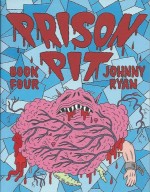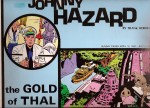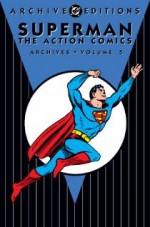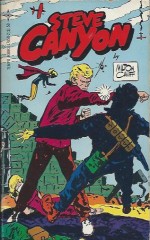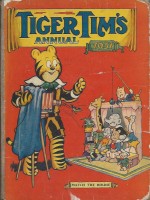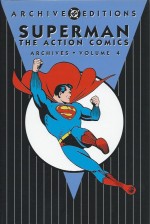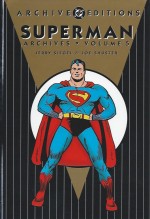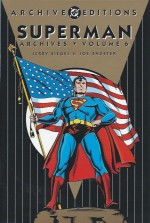
By Jerry Siegel, Joe Shuster, Don Cameron, Jack Burnley, Fred Ray, Ed Dobrotka, John Sikela, Leo Nowak, George Roussos, Pete Riss, Sam Citron & various (DC Comics)
ISBN: 1-56389-602-8
I sometimes think – like many others I know – that superhero comics were never more apt or effective than when they were whole-heartedly combating fascism with explosive, improbable excitement and mysterious masked marvel men. All the most evocative visceral moments of the genre seem to come when gaudy gladiators soundly thrashed – and please forgive the offensive contemporary colloquialism – “Nips and Nazisâ€. However, even in those long-ago dark days, comics creators were wise enough to augment their tales of espionage and imminent invasion with a barrage of gentler and more whimsical four-colour fare…
This sixth classic hardcover Superman compendium – collecting #21-24 (March/April to September/October 1943) of the World’s Premier Superhero own solo title – revisits the height of those war years with the indomitable Man of Tomorrow a thrilling, vibrant, vital role model whose sensational exploits spawned a host of imitators, a genre and an industry. His startling abilities and take-charge, can-do attitude had won the hearts of the public at home and he was embraced as a patriotic tonic for the troops across the war-torn world.
Behind stunning, morale-boosting covers by Fred Ray and Jack Burnley depicting Superman thrashing scurrilous Axis War-mongers, reminding readers what we were all fighting for and even having a gentle, stress-relieving laugh with us, scripter Jerry Siegel was producing some of the best stories of his career, showing the Man of Steel in all his ebullient glory, thrashing thugs, spies and masters of bad science whilst America kicked the fascists in the pants…
However at this time of this collection the call of armed duty caught up with the writer and Don Cameron was hired to fill the authorial void. Co-creator Joe Shuster however, exempt from military service due to his rapidly failing eyesight, was still fully involved in the creative process, despite being plagued by crushing deadlines on the syndicated newspaper strip iteration. In the comicbooks he could only manage the occasional story and was forced to merely oversee the illustration production line: drawing character faces whenever possible, but leaving the lion’s share to the burgeoning talent pool of the “Superman Studioâ€â€¦
Following the fulsome Foreword ‘A Short Flight and a Long Journey’ by distribution and retail guru Stephen A. Geppi, the all-star, full-colour action begins with the splendid, all-Siegel contents of Superman #21 starting with ‘X-Alloy’, drawn by Ed Dobrotka & John Sikela, wherein a virtual secret army of Nazi infiltrators and fifth columnists stole American industrial secrets and would have conquered the nation from within if not for the ever vigilant Man of Steel.
It was Clark Kent rather than his flamboyant alter ego who really cracked the Leo Nowak-limned case of ‘The Four Gangleaders’ who had declared war on each other, whilst in ‘The Robber Knight’ (illustrated by Shuster & George Roussos) Lois Lane was accused of shoplifting after an armour-suited Robin Hood began giving pretty women “presents†from the department store he plundered. Once again it took a real steel hero to sort things out before ‘The Ghost of Superman!’ (with Pete Riss art) saw the Action Ace play dead to trick a confession out of a cheap killer defying justice…
Light-hearted yet barbed whimsy led in the Siegel-scripted issue #22 as ‘Meet the Squiffles!’ (Riss) found Adolf Hitler approached by the king of a nefarious band of pixies who offered to sabotage all of America’s mighty weapons. Neither nefarious rogue had factored Superman – or patriotic US gremlins – into their schemes though…
A philanthropic, well-beloved gambler was framed by unscrupulous stockbrokers, but with the Man of Tomorrow’s assistance eventually regained ‘The Luck of O’Grady!’ (Sikela), after which ‘The Great ABC Panic!’ (Dobrotka) featured the return of the perfidious Prankster who almost succeeded in patenting the English language until his greatest enemy intervened, and Riss’ ‘A Modern Robin Hood’ saw the inevitable tragic end to a well-intentioned, altruistic thief who could handle Superman but not actual mobsters and gunsels…
Superman #23 opened with a Don Cameron script illustrated by Sam Citron. ‘America’s Secret Weapon!’ was a rousing paean to American military might as Clark and Lois reported on cadet manoeuvres and the Man of Steel became an inspiration to the demoralised troops in training. Siegel then wrote the rest of the issue beginning with ‘Habitual Homicide’ (Roussos art): a crime-caper worthy of Batman which began when a co-ed rebuffed her tutor’s amorous advances, prompting the unstable scholar to frame her boyfriend for murder. Unfortunately for Superman and the staff of Spurdyke University, once Professor Raymond Lock started killing he found that he really liked it…
Then ‘Fashions in Crime!’ (Riss) found Lois and Clark plunged into the world of Haute Couture and designer knock-offs, accidentally uncovering a lethally lucrative business run by a masked swell dubbed The Dude, whilst the Sikela-illustrated ‘Danger on the Diamond!’ once more combined sports action with gambling skulduggery as Superman saved the career of an on-the-skids Baseball player and cleaned up the game… again.
Cameron wrote all but one tale in issue #24, starting with a surreal Dobrotka fantasy which eschewed rational continuity to relocate the entire Superman cast back to the 1890s, where our hero saved his chaste intended from ‘Perils of Poor Lois!’
Siegel & Riss then revealed ‘The King of Crackpot Lane’ – a Marx Brothers-inspired romp which introduced whacky mute inventor Louie Dolan of the Army’s Department of Constructive Theories whose impossible gadgets made a lot of trouble for both the Man of Tomorrow and America’s enemies…
Cameron, Dobrotka & Roussos close this collection with a couple of stirring adventure yarns; first with ‘Surprise for Superman!’ which saw the Metropolis Marvel plagued by an inventive impostor who even fooled Lois, after which ‘Suicide Voyage!’ ends everything on an exuberant high as Clark – and stowaway Lois – visit the Arctic as part of a mission to rescue downed American aviators. Of course nobody was expecting a secret invasion by combined Nazi and Japanese forces, but Superman and a patriotic polar bear were grateful for the resultant bracing exercise…
Ageless and evergreen, endlessly re-readable, these epic hardback Archive Editions fabulously frame some of the greatest and most influential comics tales ever created, and taken in unison form a perfect permanent record of breathtaking wonder and groundbreaking excitement. How can any dedicated fan resist them?
© 1943, 2003 DC Comics. All Rights Reserved.

